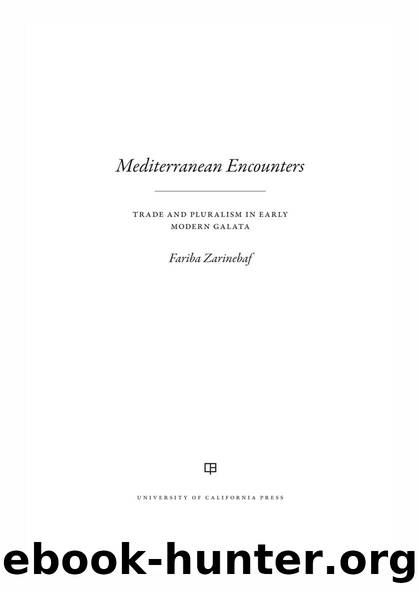Mediterranean Encounters by Fariba Zarinebaf

Author:Fariba Zarinebaf [Zarinebaf, Fariba]
Language: eng
Format: epub
Tags: History, Europe, General
ISBN: 9780520964310
Google: smNgDwAAQBAJ
Publisher: Univ of California Press
Published: 2018-07-24T01:11:29+00:00
INFORMAL BANKERS TO PASHAS: BANKRUPTCIES AND OUTSTANDING DEBTS
Due to a shortage of cash and the draining of silver coins from Ottoman ports to Iran and India, Ottoman traders largely operated on credit. In addition, money lending had become widespread in Ottoman ports due to expansion of tax farming. The state resorted to internal borrowing through the institution of tax farming while tax farmers themselves borrowed from Ottoman Armenian and Jewish money changers and French traders to purchase tax farms or to pay taxes to the government. The records of estates of many Ottoman traders and sea captains in Galata and Istanbul show a great deal of money-lending activities as well as transactions based on credit.128 In addition, many lawsuits presented to the Islamic court of Galata involved outstanding claims brought by merchants. Almost everyone with a small amount of cash, including women, became an informal banker or borrowed money in the Ottoman Empire.129 However, informal banking networks depended on trust and legal protection. The use of guarantors for financial transactions that used credit was also very important, and defaults led to lawsuits in the courts. Cash vakfs had a stronger legal foundation as charitable institutions than informal bankers did and charged lower interest rates of between 5 and 10 percent, while non-Muslim money changers (sarrafs) could charge as high as 20 percent. At times of economic crisis, defaulting also became widespread, so the courts had to promote settlement even between Ottoman and European traders to prevent total bankruptcy. Elena Frangakis-Syrett has pointed out two recurring monetary problems in Ottoman markets: the shortage of specie (coins) and currency volatility due to the shortage of liquidity and currency debasement during the eighteenth century.130
In the Ottoman Empire, merchant credit was largely based on informal financial networks that were based on trust and stretched from Ottoman to European ports. For example, French traders and diplomats in Istanbul who had a surplus of cash (because they imported more than they exported from Istanbul) were involved in a variety of activities to make money in the Levant, although their ventures were not always successful. When Ambassador Vergennes arrived in Pera in May 1755 to begin his tenure, one of his important tasks was to set the financial affairs of the French community in order. He went over the archives of the embassy and reviewed the personal papers of his predecessor, Rolland Puchot Comte de Alleurs, who had been the French ambassador from 1747 to 1754. Comte de Alleurs had married a Polish aristocratic woman and led an expensive lifestyle in Pera. He died from epilepsy in a state of bankruptcy in Pera in 1754 and was buried in the chapel of St. Louis at the French Embassy.131 He had accumulated a debt of 140,000 écus owed to the French nation in addition to 50,000 écus owed to Ottoman traders in Pera. From the reviewing the inventory of Comte de Alleursâs estate, Vergennes discovered that the previous ambassador had spent 50,000 écus acquiring furniture and luxury goods for himself and his family.
Download
This site does not store any files on its server. We only index and link to content provided by other sites. Please contact the content providers to delete copyright contents if any and email us, we'll remove relevant links or contents immediately.
The Gardeners of Salonika by Alan Palmer(148)
A History of the Peninsular War, Vol. 1, 1807-1809 by Charles Oman(103)
Red Star over the Black Sea by James H. Meyer(88)
Mediterranean Encounters by Fariba Zarinebaf(68)
The Broken Kingdom: Episode Three: Arthur's Revenge by Donald Angus(59)
The Bible War in Ireland by Irene Whelan(56)
Documenting the Past in Medieval Puglia (1130â1266) by PAUL OLDFIELD(52)
Peter H. Wilson by The Thirty Years War A Sourcebook-Palgrave Macmillan (2010)(50)
Asia in the Making of Europe, Volume III: A Century of Advance. Book 4: East Asia by Donald F. Lach; Edwin J. Van Kley(50)
The Birth of a New Europe: State and Society in the Nineteenth Century by Theodore S. Hamerow(43)
The Consumer Revolution, 1650-1800 by Michael Kwass(40)
The Virgin Mary in Byzantium, C.400â1000: Hymns, Homilies and Hagiography by Mary B. Cunningham(36)
Weeds and the Carolingians by Paolo Squatriti(31)
Pilgrim Life in the Middle Ages by Sidney Heath(29)
